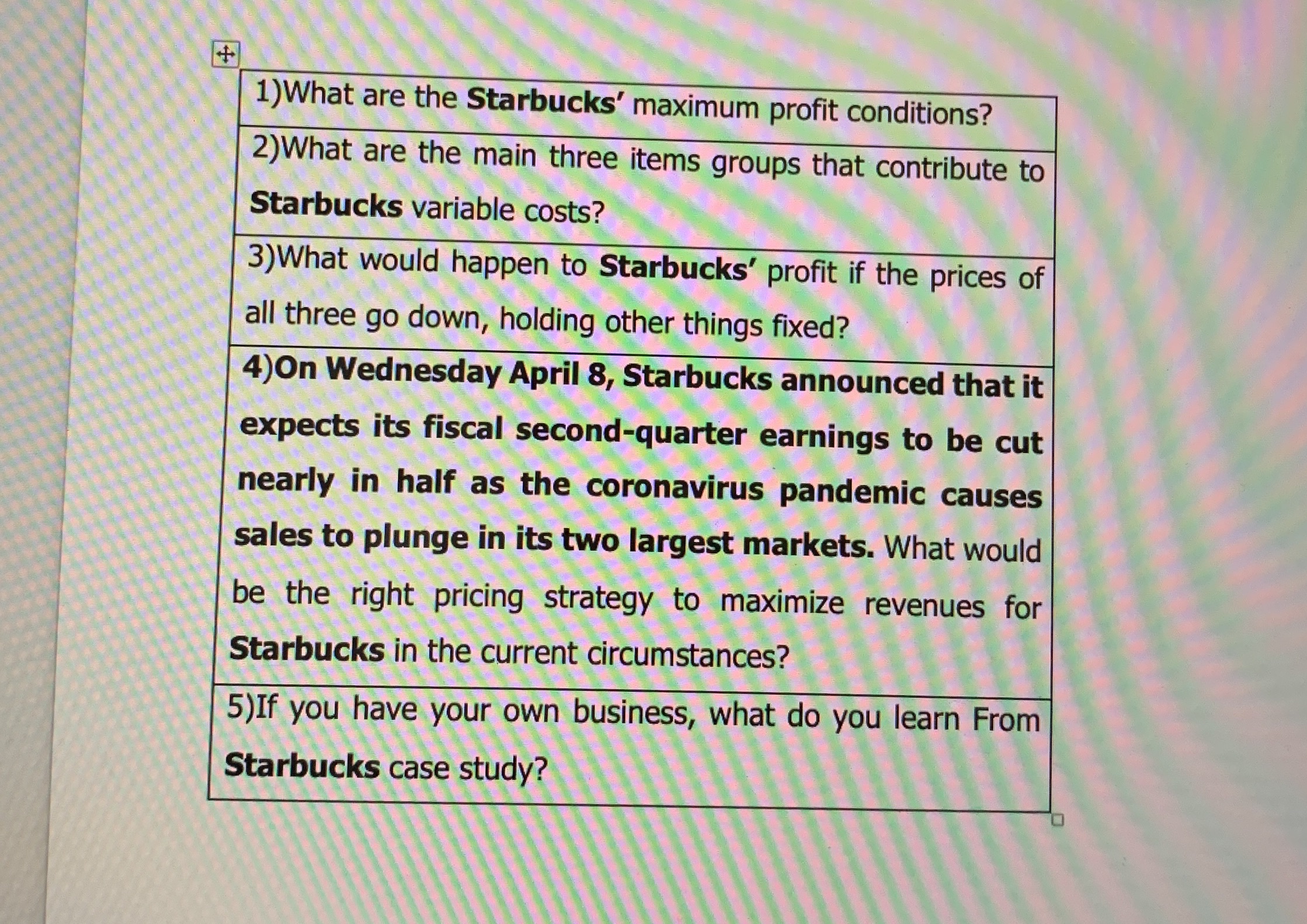Question
The Case:HOW STARBUCKS USES PRICING STRATEGY FOR PROFIT MAXIMIZATIONIn January 2020, Starbucks raised their beverage prices by an average of 1% across the U.S, a
The Case:HOW STARBUCKS USES PRICING STRATEGY FOR PROFIT MAXIMIZATIONIn January 2020, Starbucks raised their beverage prices by an average of 1% across the U.S, a move that represented the company's first significant price increase in 18 months. I failed to notice because the price change didn't affect grande or venti (medium and large) brewed coffees and I don't mess with smaller sizes, but anyone who purchases tall size (small) brews saw as much as a 10 cent increase. The company's third quarter revenue rose 25% to $417.8 million from $333.1 million a year earlier, and green coffee prices have plummeted, so what gives?Starbucks claims the price increase is due to rising labor and non-coffee commodity costs, but with the significantly lower coffee costs already improving their profit margins, it seems unlikely this justification is the true reason for the hike in prices. In addition, the price hike was applied to less than a third of their beverages and only targets certain regions. Implementing such a specific and minor price increase when the bottom line is already in great shape might seem like a greedy tactic, but the Starbucks approach to pricing is one we can all use to improve our margins. As we've said before, it only takes a 1% increase in prices to raise revenues by an average of 11%.Value Based Pricing Can Boost MarginsFor the most part, Starbucks is a master of employing value based pricing to maximize profits, and they use research and customer analysis to formulate targeted price increases that capture the greatest amount consumers are willing to pay without driving them off. Profit maximization is the process by which a company determines the price and product output level that generates the most profit. While that may seem obvious to anyone involved in running a business, it's rare to see companies using a value based pricing approach to effectively uncover the maximum amount a customer base is willing to spend on their products. As such, let's take a look at how Starbucks introduces price hikes and see how you can use their approach to generate higher profits.An Overview of the Starbucks Pricing Strategy:The Right Customers and the Right Market While cutting prices is widely accepted as the best way to keep customers during tough times, the practice is rarely based on a deeper analysis or testing of an actual customer base. In Starbucks' case, price increases throughout the company's history have already deterred the most price sensitive customers, leaving a loyal, higher-income consumer base that perceives these coffee beverages as an affordable luxury. In order to compensate for the customers lost to cheaper alternatives like Dunkin Donuts, Starbucks raises prices to maximize profits from these price insensitive customers who now depend on their strong gourmet coffee.Rather than trying to compete with cheaper chains like Dunkin, Starbucks uses price hikes to separate itself from the pack and reinforce the premium image of their brand and products. Since their loyal following isn't especially price sensitive, Starbucks coffee maintains a fairly inelastic demand curve, and a small price increase can have a huge positive impact on their margins without decreasing demand for beverages. In addition, only certain regions are targeted for each price increase, and prices vary across the U.S. depending on the current markets in those areas (the most recent hike affects the Northeast and Sunbelt regions, but Florida and California prices remain the same).Product Versioning & Price Communication They also apply price increases to specific drinks and sizes rather than the whole lot. By raising the price of the tall size brewed coffee exclusively, Starbucks is able to capture consumer surplus from the customers who find more value in upgrading to Grande after witnessing the price of a small drip with tax climb over the $2 mark. By versioning the product in this way, the company can enjoy a slightly higher margin from these customers who were persuaded by the price hike to purchase larger sizes.Starbucks also expertly communicates their price increases to manipulate consumer perception. The price hike might be based on an analysis of the customer's willingness to pay, but they associate the increase with what appears to be a fair reason. Using increased commodity costs to justify the price as well as statements that aim to make the hike look insignificant (less than a third of beverages will be affected, for example) help foster an attitude of acceptance. on Wednesday April 8, Starbucks announced that it expects its fiscal second-quarter earnings to be cut nearly in half as the coronavirus pandemic causes sales to plunge in its two largest markets.

Step by Step Solution
There are 3 Steps involved in it
Step: 1

Get Instant Access to Expert-Tailored Solutions
See step-by-step solutions with expert insights and AI powered tools for academic success
Step: 2

Step: 3

Ace Your Homework with AI
Get the answers you need in no time with our AI-driven, step-by-step assistance
Get Started


